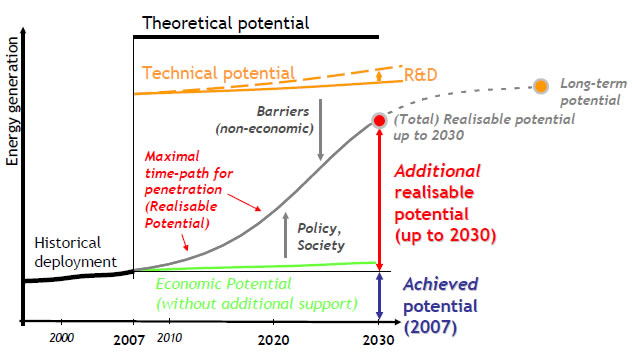2 Background information - Classification of potential categories
We start with a discussion of the general background and subsequently present the status quo of consolidated data on potentials and cost for RES in Europe as applicable in the Green-X database. These figures indicate what appears to be realisable within the 2030 timeframe.
The possible use of RES depends in particular on the available resources and the associated costs. In this context, the term "available resources" or RES potential has to be clarified. In literature, potentials of various energy resources or technologies are intensively discussed. However, often no common terminology is applied. Below, we present definitions of the various types of potentials as used throughout this report:
- Theoretical potential: To derive the theoretical potential, general physical parameters have to be taken into account (e.g. based on the determination of the energy flow resulting from a certain energy resource within the investigated region). It represents the upper limit of what could be produced from a certain energy resource from a theoretical point-of-view, based on current scientific knowledge;
- Technical potential: If technical boundary conditions (i.e. efficiencies of conversion technologies, overall technical limitations as e.g. the available land area to install wind turbines as well as the availability of raw materials) are considered, the technical potential can be derived. For most resources, the technical potential must be considered in a dynamic context. For example with increased R&D expenditures and learning-by-doing during deployment (see also chapter 4), conversion technologies might be improved and, hence, the technical potential would increase;
- Realisable potential: The realisable potential represents the maximal achievable potential assuming that all existing barriers can be overcome and all driving forces are active. Thereby, general parameters as e.g. market growth rates, planning constraints are taken into account. It is important to mention that this potential term must be seen in a dynamic context – i.e. the realisable potential has to refer to a certain year;
- Realisable potential up to 2030: provides an illustration of the derived realisable potential for the year 2030.
- Mid-term potential: in this report, long-term potentials refer to the 2050 timeframe and consequently what can be realised until then. Obviously, this is closely linked (among other constraining factors) to infrastructural prerequisites.

Figure 2-1: Definition of potential terms.
Figure 2-1 shows the general concept of the realisable potential up to 2030 as well as in the mid-term (2050), the technical and the theoretical potential in a graphical way.

